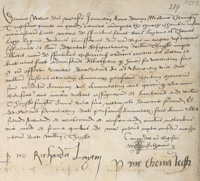 |
 |
 |
 |
 |
 |
 |
|
Fountains Abbey: History
Fountains Abbey: Buildings
|
What were the allegations against Abbot William? (2/6) …the truth is, he is a very fool and a
miserable idiot. William was charged with a number of vices, both of a personal nature and concerning his abilities as abbot. The earl of Northumberland, Henry Percy, had accused him of mismanagement and claimed he had wasted the abbey’s timber and cattle; he requested a royal commission to investigate the abbot’s character and conduct, declaring that the community would happily pay five hundred marks for his removal. A royal commission was sent to Fountains in January 1535/6 in the persons of doctors Layton and Legh, a thoroughly nasty and unscrupulous duo who arrived with a mission, namely, to find the necessary evidence to defame and depose Abbot William Thirsk. They were no doubt also eager to install as his successor Marmaduke Bradley, a monk of Fountains who had denounced Thirsk and offered the commissioners six hundred marks for the abbacy; Bradley may well have been one of the plotters who conspired against Abbot Huby, and has recently been described as ‘an ambitious and unscrupulous man’.(125)
The damning report that Layton and Legh compiled made wild allegations, charging Thirsk of immorality and mismanagement. The abbot was accused of keeping six whores, of ruining the abbey and wasting its timber. Furthermore, they claimed that only six days before their arrival Thirsk had sent his chaplain to the monastery’s treasury at midnight, to steal a jewel, which Thirsk then sold to a London goldsmith, Warren, in his chamber. According to the commissioners Thirsk botched this up, for he was deceived into thinking that the ruby was a garnet and accepted a mere £20 for the great jewel. Layton and Legh thus explained that they had accepted Thirsk’s resignation, and recommended that Marmaduke Bradley, a monk of the house – and a wealthy one at that – should be appointed in his place. Given the
lack of evidence to support these accusations, it seems that these
were most probably fabricated or, at the very least exaggerated,
to fulfil the
commission’s purpose. Like Abbot Edward
Kirkby of Rievaulx, William
Thirsk was stitched up. He was forced to resign from the abbacy
on 26 January 1536, and replaced by Layton and Legh’s choice, Marmaduke
Bradley, whom they described as the ‘wisest man in England of that
coat and well learned’,
and also – and more importantly – a wealthy man, who had offered
to pay Cromwell six hundred pounds for the abbacy immediately after
the election.(126) This, presumably, was the
real incentive behind Layton and Legh’s
choice; Thirsk was the sacrifice. Although Thirsk had been promised
a pension of one hundred marks, his successor, Marmaduke Bradley,
ensured that this
was substantially reduced, on account of his ‘naughty’ administration
of the abbacy.(127) |
